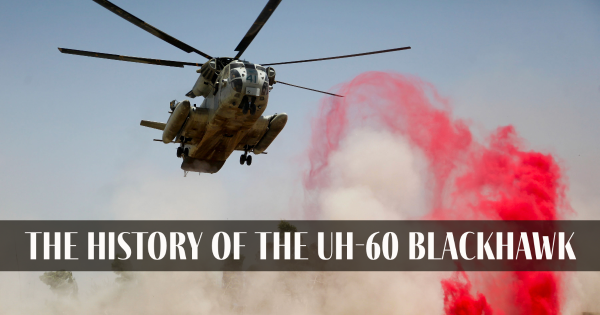Recognizing the Mechanics and Engineering Behind Uh 60 Helicopters
The UH-60 helicopter, commonly known as the Black Hawk, stands as a peak of modern rotorcraft innovation, symbolizing a mix of durable design and intricate mechanics. As we peel back the layers of the UH-60's design, a world of intricate systems and thorough engineering comes to light.
Background of UH-60 Helicopters
The history of UH-60 helicopters traces back to the late 1970s when the USA Army looked for a innovative and functional energy helicopter to replace its aging fleet. In reaction to this demand, the Sikorsky Aircraft Corporation established the UH-60 Black Hawk helicopter. Introduced in 1979, the UH-60 rapidly came to be a staple in army operations because of its remarkable capabilities.
The UH-60 was developed to master a selection of objectives, consisting of army transportation, medical discharge, electronic warfare, and special operations. Its capacity to adjust to various roles made it a useful asset to the united state Army and various other army pressures around the world
Over the years, the UH-60 platform has actually gone through numerous upgrades and variations to boost its performance and equal evolving mission demands. These helicopters have seen substantial service in problems such as the Gulf War, Afghanistan, and Iraq, showcasing their integrity and versatility in varied functional environments. The UH-60's rich history is a testimony to its long-lasting tradition as a top energy helicopter.

Engine and Power Systems
Using innovative propulsion modern technology, UH-60 helicopters are outfitted with advanced engine and power systems to ensure optimum efficiency and dependability in a series of functional situations. The UH-60, generally called the Black Hawk, is powered by 2 General Electric T700-GE-701D engines, each efficient in delivering up to 1,940 shaft horsepower. These turboshaft engines offer the necessary thrust for the helicopter to accomplish its objectives successfully, consisting of army transportation, medical emptying, and combat support.

Rotor System and Aerodynamics
Just how do the rotor system and the rules of aerodynamics of UH-60 helicopters contribute to their functional effectiveness and flight abilities? The blades system of the UH-60 helicopter plays a vital duty in offering lift and propulsion.
Aerodynamics likewise play a key role in the performance of UH-60 helicopters. The structured body and rotor blade design lower drag, enabling the helicopter to attain greater rates and far better gas performance. check here The wind resistant style of the UH-60 additionally adds to its capacity to run in varied environmental problems, consisting of high altitudes and warm temperatures.
Avionics and Flight Control Solution

In its elaborate control with the rotor system and the rules of aerodynamics of UH-60 helicopters, the avionics and trip control systems create a vital network of innovations forming the aircraft's functional capacities. Avionics incorporate the electronic systems utilized for communication, navigating, and monitoring various airplane functions. In the UH-60, these systems include digital screens, interaction radios, general practitioner navigation, climate radar, and autopilot systems. These avionics systems offer vital info to the pilots, enhancing situational awareness and guaranteeing safe and effective operation of the helicopter.
The flight control systems of the UH-60 are in charge of converting the pilot's inputs right into the ideal adjustments to the blades system, making sure steady flight and ability to move. These systems are composed of hydraulic actuators, servos, and computers that interact to manage the primary and tail blades, along with other flight control surface areas. By precisely managing the helicopter's trip dynamics, these systems allow my link pilots to do a vast array of objectives, from transportation and search-and-rescue to battle procedures, with precision and confidence.
Role and Applications in Aviation
The role and applications of avionics and flight control systems in air travel are indispensable to making sure the risk-free and efficient operation of aircraft, including UH-60 helicopters. Avionics systems in UH-60 helicopters incorporate a series of electronic systems that aid in navigation, interaction, monitoring, and managing different aircraft features. These systems include electronic display screens, autopilot systems, interaction radios, GPS navigating tools, and climate radar. Flight control systems play an essential function in navigating the helicopter airborne, keeping security, and making sure exact movements. The fly-by-wire modern technology utilized in contemporary UH-60 helicopters converts pilot inputs right into electronic signals, which are then translated by the trip control computers to adjust the airplane's control surfaces. In addition, these systems include safety attributes such as autopilot settings, surface recognition cautioning systems, and stability enhancement systems to improve the overall safety and functional abilities of the UH-60 helicopters in numerous missions, including troop transportation, medical emptying, search and rescue, and aerial firefighting.
Final Thought
In conclusion, the UH-60 helicopter is a versatile aircraft with a rich background and progressed engineering. Its engine and power systems, blades system, the rules of aerodynamics, avionics, and trip control systems all work with each other to make it a trusted and effective equipment.
In its intricate control with the blades system and the rules of aerodynamics of UH-60 helicopters, the avionics and trip control like it systems create a critical network of modern technologies shaping the airplane's functional abilities.The flight control systems of the UH-60 are liable for translating the pilot's inputs into the suitable adjustments to the rotor system, ensuring secure flight and maneuverability. Avionics systems in UH-60 helicopters include a variety of digital systems that aid in navigation, interaction, surveillance, and controlling various airplane functions. Furthermore, these systems include safety attributes such as auto-pilot modes, surface understanding advising systems, and security augmentation systems to improve the general safety and operational abilities of the UH-60 helicopters in different goals, consisting of army transport, medical evacuation, search and rescue, and airborne firefighting.
Its engine and power systems, blades system, aerodynamics, avionics, and flight control systems all work with each other to make it a efficient and reliable maker.